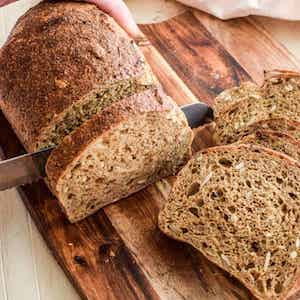Fig and Walnut Sourdough
This fig and walnut sourdough is soft and tender, with a delicious crunch of walnuts and sweet figs. It’s the perfect bread to serve with a hunk of artisanal cheese!

The bread recipe base uses bread flour and 20% wholemeal wheat flour. It’s a great base to which I love adding different additions, like seeds, fruits, and nuts. In this case, it’s now a fig and walnut sourdough bread, but I’ve also used it to make flavors like cranberry and pecan, cherry and chocolate, or caraway seeds.
The bread undergoes a 3-hour period in which you’ll give the dough stretch and folds, and the nuts and fruit are folded in. After this, it bulk ferments until puffy. After this, it’s shaped, cold-proofed, and baked in the morning.

Ingredients
Here’s what you need. Find the amounts in the printable recipe card at the bottom of this post.
- Bread flour and wholemeal flour
- Active sourdough starter – Ensure your starter is in optimum condition and not overly acidic or past its peak.
- Water
- Salt
- Walnuts and dried figs. Feel free to swap with pecans and other fruits like cranberries, prunes, or raisins.
The Sourdough starter
I create a seperate levain for my breads. This is an offshoot of starters, where I feed a bit of my established starter separately. Then, this whole offshoot goes into the bread. I feed the offshoot at a 1:2:2 ratio; starter:flour: water, or 1:3:3 or 1:4:4 if I want to slow down the growth.
This keeps the seed starter amount smaller than the added flour and water, which helps reduce the starter’s acid content and prevent it from peaking too quickly.
If you feed your starter differently, that’s fine, but I recommend using an active starter fed and refreshed regularly so the acid content is low.
Method
- Mix together the starter ingredients in a bowl and stir well until thoroughly mixed. Add it to a clean jar and loosely cover it. Leave it in a warm spot until it doubles in size.
- Gently toast the walnuts in a dry pan over medium heat for a 3-4 minutes until fragrant. Let them cool, then break them apart into rough pieces. Chop the figs into small pieces. Set these aside for now.
- When the starter has almost finished rising, combine the bread flour, whole wheat flour, and water in a large mixing bowl. Use a fork or wooden spoon to bring it together, then switch to wet hands to mix it into a shaggy dough ball with no dry bits of flour remaining.
- Cover the bowl and let it autolyze at room temperature until the starter is ready.
- Add the starter to the dough and squish it in using wet hands. Add in the salt and mix it in.
Bulk fermentation

- Over the next 3 hours, stretch and fold this dough every 30 minutes. Pull the dough up and over itself, turn the bowl a quarter turn, and repeat.

- Do this on all sides, and always use wet hands.

- As the folds go on, I like to tuck them underneath the dough ball to create a smooth top.

- After about four sets of stretch and folds, add 1/2 of the mix-ins over the top of the dough. Fold them into the dough, then repeat with the rest of the add-ins.
- Cover the dough and let it rise in a warm spot, ideally around 77°F/25°C, until bulked out by around 50%. The dough doesn’t need to double in size, but it should have an obvious rise and jiggle if you shake the bowl.
- You can create a warm proofing spot by placing the bread dough in a turned-off oven and adding a dish of boiled water at the bottom. Replace the water as it cools down.

Shaping and cold-proof
- Line a banneton basket with a kitchen towel and flour it well.
- Tip your dough carefully on a lightly floured work surface and gently form it into a rectangle.

- Take the bottom third of the dough and fold it up so it meets the middle.

- Take the right side of the dough and fold it to meet the middle.
- Then, take the left side of the dough and fold it into the middle.
- Bring the top third of the dough down to the middle to create a little dough packet.
- Now add some stitches down the dough by grabbing some dough from the top left and a little from the top right and bringing them together to meet in the middle.
- Carry on doing this down the length of the dough. When you reach the bottom, grab the bottom of the dough and carry it over the stitched dough to meet at the top. This will create a log.

- Now, gently grab this log and roll it gently towards you on the bench. This will create some surface tension. All the while, take care not to de-gas your dough too much.

- Place the shaped dough in the floured bowl or basket, seam-side up.
- Cover the dough, or place it in a large ziplock bag and seal. Cold-proof in the refrigerator for 8-16 hours.
Baking
- The next day, preheat the oven and a Dutch oven to 450°F/230°C for at least 30 minutes until well-heated.
- Remove the hot Dutch oven and flour the bottom well. Take the dough from the fridge and carefully flip it out of the basket, into the Dutch oven.
- If baking this in a large pot, it’s best to tip your dough onto a piece of parchment paper. This way, you can lower it into the pot.
- Score the dough using a razor blade or sharp knife.
- Bake covered with the lid for around 20 minutes.
- Remove the lid and bake uncovered for 20 minutes more, depending on your preference or your oven. Some ovens run hotter and may need less time, while others need more time.
- Let the sourdough cool for at least two hours before slicing.

Related recipes
You might like these too!

Fig and Walnut Sourdough
This fig and walnut sourdough is soft and tender, with a delicious crunch of walnuts and sweet figs. It’s the perfect bread to serve with a hunk of artisanal cheese!
Ingredients
Starter
- 25g sourdough starter
- 50g bread flour
- 50g water
Dough
- 320g bread Flour
- 80g whole wheat flour
- 285g water
- All the sourdough starter (Approx. 100g)
- 7g salt
- 80g walnut halves
- 60g dried figs
Instructions
- Mix together the starter ingredients in a bowl and stir well until thoroughly mixed. Add it to a clean jar and loosely cover it. Leave it in a warm spot until it doubles in size.
- Gently toast the walnuts in a dry pan over medium heat for 3-4 minutes until fragrant. Let them cool, then break them apart into rough pieces. Chop the figs into small pieces.
- When the starter has almost finished rising, combine the bread flour, whole wheat flour, and water in a large mixing bowl. Use a fork or wooden spoon to bring it together, then switch to wet hands to mix it into a shaggy dough ball with no dry bits of flour remaining. Cover the bowl and let it autolyze at room temperature until the starter is ready.
- Add the starter to the dough and squish it in using wet hands. Add in the salt and mix it in.
Bulk fermentation
- Over the next 3 hours, stretch and fold this dough every 30 minutes. Pull the dough up and over itself, turn the bowl a quarter turn, and repeat. Do this on all sides, and always use wet hands.
- After about four sets of stretch and folds, add 1/2 of the mix-ins over the top of the dough. Fold them into the dough, then repeat with the rest of the add-ins.
- After all the folds have been performed, cover the dough and let it rise for 2-3 more hours in a warm spot, ideally around 77°F/25°C, until bulked out by around 50%. Watch the dough, not the clock. This timing will change depending on your own room temperature and starter strength.
- The dough doesn't need to double in size, but it should have an obvious rise and jiggle if you shake the bowl. You can create a warm proofing spot by placing the bread dough in a turned-off oven and adding a dish of boiled water at the bottom. Replace the water as it cools down.
Shaping and cold-proof
- Line a banneton basket with a kitchen towel and flour it well.
- Tip your dough carefully on a lightly floured work surface and gently form it into a rectangle.
- Take the bottom third of the dough and fold it up so it meets the middle. Take the right side of the dough and fold it to meet the middle.
- Then, take the left side of the dough and fold it into the middle.
- Bring the top third of the dough down to the middle to create a little dough packet.
- Now add some stitches down the dough by grabbing some dough from the top left and a little from the top right and bringing them together to meet in the middle.
- Carry on doing this down the length of the dough. When you reach the bottom, grab a flap of dough and carry it over the stitched dough to meet at the top. This will create a log.
- Now, gently grab this log and roll it gently towards you on the bench. This will create some surface tension. All the while, take care not to de-gas your dough too much.
- Place the shaped dough in the floured bowl or basket, seam-side up.
- Cover the dough or place it in a large ziplock bag and seal. Cold-proof in the refrigerator for 8-16 hours.
Baking
- The next day, preheat the oven and a Dutch oven to 450°F/230°C for at least 30 minutes until well-heated.
- Remove the hot Dutch oven and flour the bottom well. Take the dough from the fridge and carefully flip it out of the basket and into the Dutch oven. If baking this in a large pot, it's best to tip your dough onto a piece of parchment paper. This way, you can lower it into the pot.
- Score the dough using a razor blade or sharp knife.
- Bake covered with the lid for around 20 minutes. Remove the lid and bake uncovered for 20 minutes more, depending on your preference or your oven. Some ovens run hotter and may need less time, while others need more.
- Let the sourdough cool for at least two hours before slicing.






